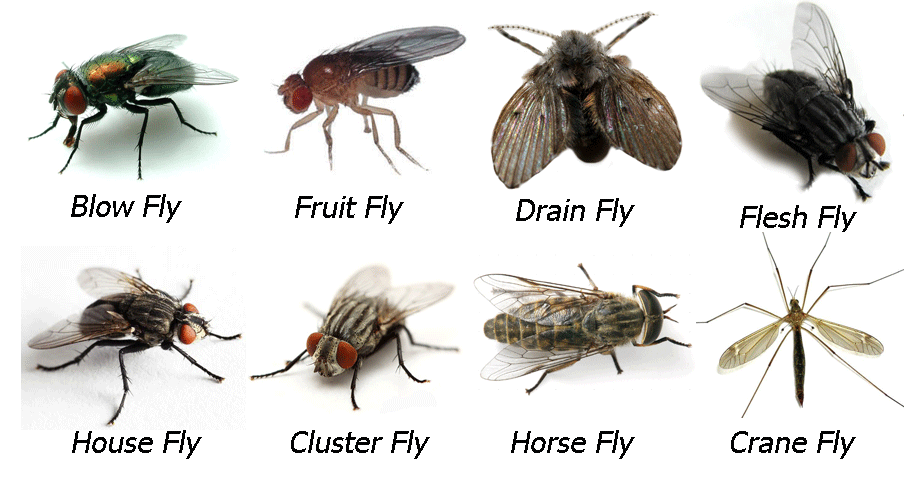How to Get Rid of Flies in Your Home
Non-biting flies, such as houseflies, are not only nuisance, but they are also responsible for transmitting diseases and contaminating food. For instance, flies are capable of contaminating food and transferring more than 100 pathogens, including malaria, salmonella and tuberculosis. Food contamination is one of the main reasons that fly pest control is so important. Flies prefer warm temperatures and are most active from late spring to early autumn. In order to best repel flies during this time, limit access to your home as much as possible, keeping doors and windows closed.
If you have a fly infestation in your home, give us a call. We will be able to inspect your home, confirm the species and recommend a course of pest control to treat and get rid of the flies.
Fruit Flies
Fruit flies get their common name from their small size and fondness of some fruits. Small fruit flies are nuisance pests, but may transmit diseases. Fruit flies only live for 8-10 days. In that time, females lay around 500 eggs, using rotting fruit or vegetables as their nest. They have 6 legs, tan in color, small and oval in shape and about 1/8” in size.
Diet: Fruit flies feed on decaying fruits and vegetables.
Habitat: Fruit flies are commonly found in homes, restaurants and other facilities where food is processed. They are especially attracted to garbage that has just been sitting around.
Impact: Fruit flies are found in unsanitary conditions like garbage dumps and trashcans. When they are around, humans can become very sick.
Prevention: Keep your home clean. Remove trash often and keep kitchen counters clean. Remove rotting food from your home immediately.
House Flies
These pests get their name from being the most common fly found around homes. Adult House flies can grow to one-quarter of an inch long and usually live between 15 and 25 days. House flies taste with their feet, which are 10 million times more sensitive to sugar than the human tongue! House flies have six legs, are small and oval in shape, dark grey in color and about ¼” in size.
Diet: Flies do not have teeth or a stinger. Their mouths absorb food like a sponge. They can only eat liquids but they can turn many solid foods into a liquid through spitting or vomiting on it. Their tongues are shaped like straws so they can suck up their food. They eat any wet or decaying matter, but they are particularly attracted to pet waste because the odor is strong and it is easy for them to find.
Habitat: House flies tend to stay within 1-2 miles of where they were born but will travel up to 20 miles to find food. They breed in garbage cans, compost heaps and pet areas.
Impact: These insects have been known to carry over 100 different kinds of disease causing germs.
Prevention: Keep your homes clean. Remove trash often and seal your garbage cans. Clean up pet waste immediately. Use fine mesh door and window screens to prevent flies from getting into your home.
Fly Facts
- Depending on the species, the life expectancy of a fly is eight days to two months or, in some cases, up to a year.
- Flies belong to the order Diptera, meaning two wings. There are more than 16,000 species of flies in North America.
- Flies plague every part of the world except the polar ice caps.
- One pair of flies can produce more than 1 million offspring through their offsprings’ offspring in a matter of weeks.
- Millions of microorganisms may flourish in a single fly’s gut, while a half-billion more swarm over its body and legs.
- Flies spread diseases readily because they move quickly from rotting, disease-laden garbage to exposed human foods and utensils.
- Because they only have two wings, flies land often and therefore can deposit thousands of bacteria each time they land.
- U.S. Department of Agriculture sources reveal that flies contaminate or destroy $10 billion worth of agricultural products annually.
- Every time a fly lands, it sloughs off thousands of microbes. If a fly lands on food or utensils, customers may ingest germs that can trigger serious illness such as diarrhea, food poisoning, meningitis and bloodstream infections.
- When flies feed on waste, they collect pathogens on their legs and mouths. These pathogens are then transferred to food on tables or counters when a fly lands again. Flies regurgitate on solid food then they eat the liquid. They are capable of transmitting disease when they vomit, groom themselves or just walk on surfaces.
